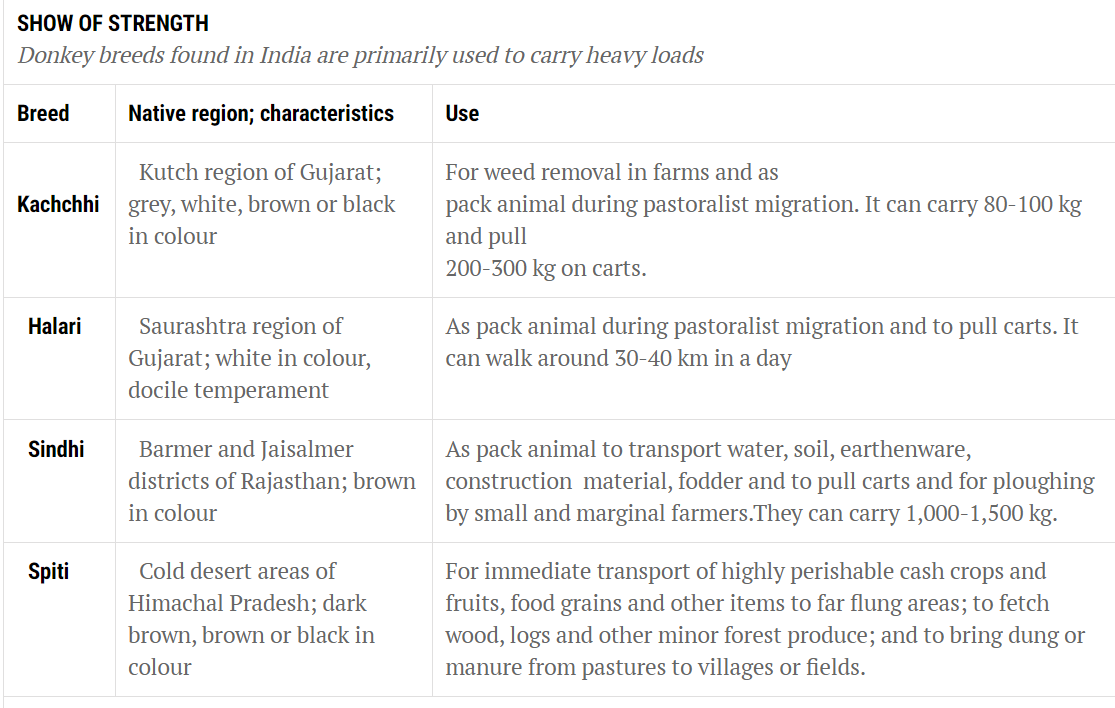Important Facts For Prelims
African Union Banned Donkey Skin Trade
- 23 Feb 2024
- 6 min read
Why in News?
Recently, during the 37th African Union Summit, 2024 in Ethiopia, African heads of state unanimously agreed to a historic ban on the trade of donkey skin, thereby prohibiting the killing of donkeys across the continent for their hides.
- This is a significant outcome following the Dar es Salaam declaration adopted at the first African Union-Interafrican Bureau for Animal Resource (AU-IBAR) Pan-African Donkey Conference in December 2022.
What is the Dar es Salaam Declaration?
- About:
- The Dar es Salaam declaration was signed in Tanzania during the Pan African Donkey Skin Conference, organised by the AU-IBAR, where government ministers gathered to understand the harmful effects of the donkey skin trade on animals and communities in Africa.
- It underscores the rapid decrease in Africa's donkey population and advocates for increased investment in research, policies, and legislation to safeguard the species.
- It advocates for an African Union Commission resolution proposing a 15-year halt on the commercial slaughter of donkeys for their skins, alongside the creation of an African donkey strategy addressing exploitation, production, and productivity, to integrate these concerns into the global development agenda.
Why is Donkey Skin Traded?
- About:
- The donkey skin trade, which is largely unregulated, involves cruel practices such as viciously slaughtering donkeys for their skins, which are then exported to China.
- The trade is illegal in some countries and legal in others causing cruelty and suffering to donkeys globally.
- The donkey skin trade, which is largely unregulated, involves cruel practices such as viciously slaughtering donkeys for their skins, which are then exported to China.
- Uses:
- The collagen from the donkey skins is used to create a product known as ejiao (a traditional Chinese medicine) which is then used in food, drink, and beauty products.
- Negative Effect:
- On Donkeys: The treatment of donkeys throughout the skin trade, from sourcing to slaughter, has caused intense suffering, with hundreds of thousands slaughtered over the past decade.
- On Owners: The global trade in donkey skin jeopardises efforts towards achieving at least nine out of the 17 United Nations sustainable development goals, including ending poverty, as donkeys are crucial to millions of people for whom equid ownership serves as the sole means to escape extreme poverty.
- The donkey skin trade significantly impacts women and children, reducing economic and educational opportunities by depriving them of the support of these animals, which are crucial for completing tasks efficiently. E.g. fetching water, and using as a draught animal.
Key Facts about Indian Wild Ass
- Sub-species of Asian Wild Ass (Equus hemionus)
- Distinguished by unique white markings on the front of the rump and back of the shoulder, along with a stripe down the back outlined in white.
- Distribution: The World’s last population of Indian WildAss is restricted to Rann of Kachchh, Gujarat.
- Habitat: Desert and grassland ecosystems.
- Conservation Status:
- IUCN: Near threatened
- CITES: Appendix II
- Wildlife Protection Act (1972): Schedule-I
UPSC Civil Services Examination, Previous Year Question (PYQ)
Prelims:
Q. According to the Wildlife (Protection) Act, 1972, which of the following animals cannot be hunted by any person except under some provisions provided by law? (2017)
- Gharial
- Indian wild ass
- Wild buffalo
Select the correct answer using the code given below:
(a) 1 only
(b) 2 and 3 only
(c) 1 and 3 only
(d) 1, 2 and 3
Ans: (d)
Exp:
- Gharial, Indian wild ass and Wild buffalo are all listed under Schedule I of the Wildlife (Protection) Act 1972.
- The Wildlife (Protection) Act 1972 prohibits hunting of any animal enlisted in Schedule I of the Act except under some provisions provided by law.
- Further, the section 11 of the Act states that the chief wild life warden may, if he is satisfied that any wild animal specified in Schedule I has become dangerous to human life or is so disabled or diseased as to be beyond recovery, by order in writing and stating the reasons therefore, permit any person to hunt such animal or cause such animal to be hunted.
- The killing or wounding in good faith of any wild animal in defence of oneself or of any other person shall not be an offence.
- Therefore, option (d) is the correct answer.
Q. Which one of the following groups of animals belongs to the category of endangered species? (2012)
(a) Great Indian Bustard, Musk Deer, Red Panda and Asiatic Wild Ass
(b) Kashmir Stag, Cheetal, Blue Bull and Great Indian Bustard
(c) Snow Leopard, Swamp Deer, Rhesus Monkey and Saras (Crane)
(d) Lion-tailed Macaque, Blue Bull, Hanuman Langur and Cheetal
Ans: (a)
Q. A sandy and saline area is the natural habitat of an Indian animal species. The animal has no predators in that area but its existence is threatened due to the destruction of its habitat. Which one of the following could be that animal? (2011)
(a) Indian wild buffalo
(b) Indian wild ass
(c) Indian wild boar
(d) Indian gazelle
Ans: (b)





